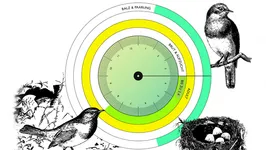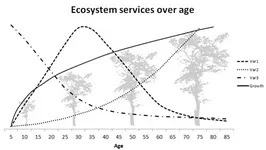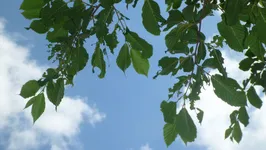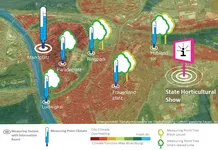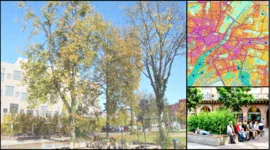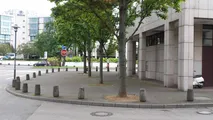Climate Protection and Green Infrastructures in the City
Climate protection with the help of green infrastructure: How can climate change be countered and the resilience of Bavarian cities in terms of climate change be improved? This is explored through case studies in city quarters and consideration of the interaction of ecosystem services, energy savings at the building and neighborhood level as well as renewable energies.
100Places:M
How can public places look in the future? Due to the investigation of 100 public places in Munich and the analysis of the interacting effects of climate change and the heat island effect as well as design, use and appropriation of public places, this question will be examined within the framework of the project.
Wuerzburg Climate Experience
Cities are characterized by a specific climate compared to their rural surroundings. Based on several sites within the city of Würzburg this project aims at uncovering in which way the climate of urban sites differs depending on urban greening (trees) and how urban trees change the climate of an urban site and vice versa. In this way, the relevance of trees for urban planning can be demonstrated.
Colorful Ribbons for our Cities in Times of Climate Change
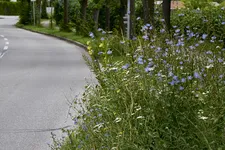
The stable growth of many cities and the increasing amount of soil sealing in rural areas change the landscape and the habitats of many animal and plant species. The project therefore studies the biodiversity of urban green, it's esthetic and spatial planning tasks and it's function of climate regulation.
ClimateContainerTrees
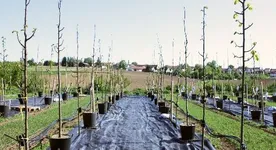
The research project aims to close existing knowlege gaps in relation to the climatic effect and growth conditions of trees in containers as well as to properly plant new trees in containers for use as a sustainable urban climatic effective measure.
Ecosystem Services of Urban Green
The design of public squares and city green is often driven by esthetics. However, climate change poses problems, the thermal comfort of humans is poor at sealed squares. With two modelling approaches, this project will analyse the ecosystem services of urban green and further quantifiy the effects of changes concerning climate and existing structures.
Redensification in the Context of Climate Change
Cities are most vulnerable to climate change. Redensification processes should be performed holistic, climate resilient and resource-conserving. With 3D-city models, simulation and visualisation methods will be developed, alleviating the evaluation of planning alternatives in municipal assessment processses.
Multifunctional infiltration swales in residential areas
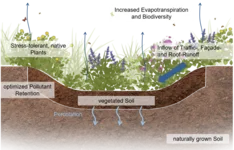
Cities are currently experiencing above-average growth. In metropolitan areas, there is often a lot of redensification, development of new building areas and reduction of inner-city green spaces. Climate change is also increasing the frequency, duration and intensity of extreme weather events. This poses great challenges for stormwater management. Vegetated above-ground infiltration swales are considered promising for the natural management of stormwater runoff in urban areas.
Scientific accompanying research: "Climate friendly building - model project"
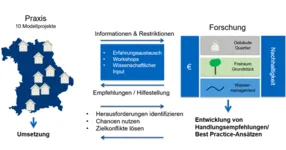
Climate protection plays an important role in today's building practice, guidelines contribute to the reduction of energy consumption and CO2 emissions of buildings. Climate adaptation, however, is hardly integrated into planning processes. This project is concerned with exploring the interactions and identifying synergies of planning measures to improve the micro- and macro-climate in cities (with buildings, green infrastructures) and strategies for rainwater and greywater harvesting.
Animal Aided Design III - Monitoring and Evaluation
Within the framework of a research project - Animal-Aided Design - a strategy for climate adaptation and biodiversity conservation was tested in Munich. In the current project a success control is explored, whether animals can be included by the method AAD in planning up to the realization and a contribution can be made to the adaptation of climate sensitive areas to the consequences of climate change.
Climate Biomonitoring with Lichens in Bavaria
Lichens are communities of fungi and algae or cyanobacteria that settle on tree bark, rocks or on the ground. Due to their direct contact with the atmosphere, without a protective wax layer as in higher plants, they react extremely sensitively and relatively early to changes in temperature and humidity. With climate change, the diversity of the lichen population is therefore also changing, and several species are classified as climate change indicators.
Interactive guideline "Urban trees under climate change"
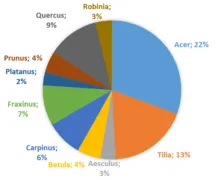
An online simulation module for estimating the growth and ecosystem services of the most common tree species in Bavarian cities.
Asian tiger mosquito in cities
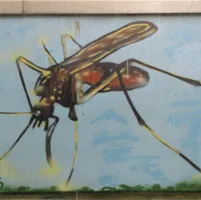
The aim of this research project is to summarise the current state of knowledge on Ae. albopictus in urban areas in order to create a basis for urban climate adaptation measures and their implementation. These should be designed in such a way that they do not encourage the establishment of the Asian tiger mosquito and thus the risk of transmission of diseases associated with Ae. albopictus in urban areas.
CUT
The international research project - funded by the DFG Middle East Co-operation - deals with the growth and ecosystem services of trees in cities along a climatic gradient. The effects of the urban microclimate on tree growth and the associated services (shading, cooling, carbon storage) are quantified under the current climate and future climate change scenarios. In addition to cities with temperate climates in Germany, cities in Israel, Palestine and Jordan with Mediterranean and arid climates will be analysed.
Cleanvelope
For typical settlement structures, the junior research group investigates design and consideration strategies for effective solar and greening measures in the building envelope and the optimised use of solar energy, load management and storage potential in the context of neighbourhood energy concepts. A CAD-linked neighbourhood model developed for this purpose links the electricity, heating and transport sectors and integrates the simulation of the microclimate. Implementation strategies are to be developed together with local authorities and the findings tested in real-life case studies.
ECO+
The ‘Regenerative Design’ concept serves as the basis for the ECO+ research project. This is characterised by a more flexible planning approach with the aim of achieving positive environmental effects and seeing buildings as part of the surrounding nature. We understand ‘positive building’ and the concept of regenerative design in particular as a way of thinking that goes far beyond the shifting of system boundaries and is based on a holistic view of the world, in which people and their actions are seen in relation to nature in a holistic approach. In this context, the term ECO+ encompasses ecological, economic and social aspects.s.
Green City of the Future
The aim of the joint project is to support cities in achieving their long-term climate policy goals and to promote the development of climate-resilient neighbourhoods. In addition to the further development of existing climate protection and climate adaptation strategies, against the backdrop of climate change, the focus is primarily on the consideration of green and open spaces, which are under extreme pressure due to rising population figures.
Re-use of waste bricks as substrate for land-fill coverage and tree plantings
The aim of the project is to re-use brick waste as innovative planting substrate. Such substrate should improve water and nutrient storing by adding brick rubble. A greenhouse experiment will investigate the effect of brick addition on grasslands as well as trees saplings. Experimental plants are species of oatgrass meadows and the trees Acer platanoides and Tilia cordata. The experiment should reveal which physico-chemical treatment of bricks is most effective, and how high the ratio of bricks to soil should be. Moreover, additives like mycorrhiza and different moisture regimes will be tested.
Renaturalisation of biodiversity and ecosystem services of urban landscapes to improve climate resilience and invasion resistance
Grüne Infrastruktur in Städten hat eine große Bedeutung bei der Abschwächung negativer Folgen des Klimawandels, da sie die Durchschnittstemperaturen senkt und die Luftfeuchtigkeit erhöht. Weitere Ökosystemleistungen sind Wasserretention bei Starkregen, Verminderung von Erosion, Bindung von Kohlenstoff und Nährstoffen sowie eine Förderung der Biologischen Vielfalt. Zudem begünstigt grüne Infrastruktur die Erholung der Stadtbewohner. Wichtige Herausforderungen bei der Gestaltung solcher Grünflächen sind Resilienz gegenüber extremer Witterung, Resistenz gegen invasive Fremdarten und ein günstiges Kosten-Nutzen-Verhältnis.
INTERESS-I
In order to sustainably improve the urban climate, green and blue infrastructures need to be maintained and expanded. This results in a considerable additional demand for water during the growing season and especially during midsummer heat waves. Alternative water resources must be tapped, their suitability for irrigation determined, storage methods tested and new forms of public greenery developed. The project ‘Integrated strategies for strengthening urban blue-green infrastructures’ INTERESS-I focuses on this challenge and examines the conditions for success and obstacles to an integrated urban blue-green infrastructure using the examples of Stuttgart and Frankfurt.

